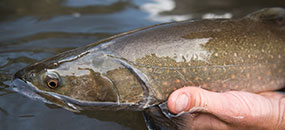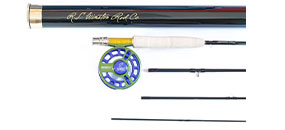Associated Press photo by Mike Groll
The Mohawk Indian Tribe of upstate New York is the first American Indian tribe to decommission and remove a federally licensed dam, and that removal could be a fruitful development for anadromous fish running from the St. Lawrence River into the St. Regis River that flows through the tribe's historic lands.
The removal of the 11-foot-tall Hogansburg Dam could help everything from increasingly rare Atlantic salmon and sturgeon. Both species historically migrated up the 87-mile river that flows into the St. Lawrence southwest of Montreal, Quebec, before the dam was constructed more than 100 years ago. The removal was funded as part of a pollution settlement with industrial interests in the area, and part of the Mohawk Tribe's efforts to restore their native lands and bring back important hunting and fishing pastimes.
There's good news for fish out West, too, where a dose of reality finally set in on the whole public lands transfer and liquidation front. Wyoming Gov. Matt Meade said last week that transferring public lands to the state is not only illegal, but it's also financially impractical. This is nothing new—university studies in Colorado, Utah and Idaho have all determined that states just don't have the financial wherewithall to handle such onerous management expenses if public lands were transferred to the states. This instance is unique, however, because a sitting western governor is announcing these realities to the Wyoming Legislature that seems dead-set on pursuing this hare-brained idea (and wasting taxpayer money to do it).
Other western governors ought to follow suit. Transferring America's public lands—acreage that belong to every single one of us as a birthright and a legacy to be handed down to coming generations—is a bad idea.
Video of the day
And, finally, maybe the best news of the week. After years of saying it was time for logging in southeast Alaska's Tongass National Forest to shift from old-growth stands of spruce, cedar and fir that are vital to healthy salmon and trout streams, the U.S. Forest Service made it official. The logging emphasis on the Tongass will shift to second-growth trees, under the notion that thinning out thick stands of smaller timber will allow for the future harvest of larger trees in a forest that, if managed properly, can truly be renewable. What's more, the 77 watersheds identified by TU on the Tongass as vital to salmon, trout and char will be protected.
A Stikine River pink salmon made this angler's day. Pinks, cohos, kings, chums and sockeyes all call the Tongass National Forest home.
That's great news for fish ... and for both commercial and recreational anglers who have known for years that "America's Salmon Forest" must be properly managed if salmon are to remain in healthy abundance.
— Chris Hunt





